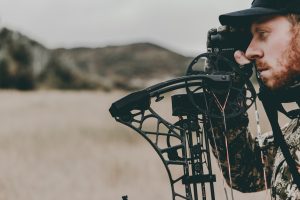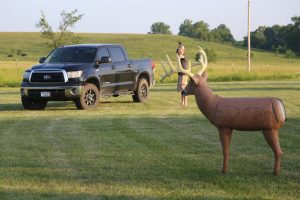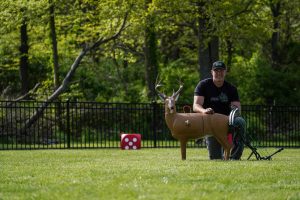Turn up your deadliness with these quick tips.
The muley buck nudged the doe until he was situated broadside and 61 yards away from me. I knew my opportunity would soon fade, so I promptly drew my bow, put the correct pin on his side and released. When I first saw my arrow’s trajectory, I worried that it would whizz over the buck. Instead, it dropped perfectly into his chest just behind the shoulder. He sprung off and within a short distance, his legs gave out. The dandy 4×4 buck was mine.
Nothing in bowhunting satisfies like watching an arrow punch perfectly behind the shoulder of a deer, elk or any other big-game animal. Not only does that outcome confirm that you delivered under intense pressure, but it also typically entails a short blood trail or even a dead-within-view kill. Unfortunately, not every shot opportunity concludes so favorably.
While bowhunting has many different variables, most mistakes result from human error, such as a lack of preparation and low proficiency. Bowhunting and archery in general are very complex. The question is whether we have to become involved enough to truly dial in to reach a level of proficiency that makes our efforts more prone to victory than failure. Chew on that a bit. I think most bowhunters would welcome more accuracy when they bowhunt.
When I think about sufficient involvement for bowhunting proficiency, the following six points come to mind. If you get these right, I bet you’ll boost your bowhunting accuracy.
-
Know Your Bow Like the Back of Your Hand
Developing true proficiency with any tool—miter saw, guitar or archery equipment—comes from time spent with it. That’s why it’s important to either get out your existing bow or purchase a new one months before bowhunting season arrives. The more time you spend with your bow, the more it will become like a part of your body.

When you know your bow extremely well, its grip will feel unbelievably familiar, even with your eyes closed. Gripping it correctly will become like second nature. When you acclimate to the draw cycle, you’ll get used to how the bow falls as you follow through with your shot. The more comfort and familiarity you develop with your bow, the more deadly you will feel when you take it hunting.
-
Develop a Sequence
Operating on autopilot is quite common for bowhunters in the heat of a shot opportunity. Often, we experience a huge adrenaline surge coupled with tunnel vision, and we react almost automatically rather than separating the encounter into multiple tasks. That’s when simple oversights can lead to a poor hit or a miss.

When you practice, develop a sequence of tasks for properly executing your shot. Mentally rehearse each step as you execute it. Memorize the sequence. This will look a little bit different for everyone, so determine what works for you individually. You must be able to easily remember it and be able to carry out each task quickly, since deer and elk don’t always give tons of time to shoot. Then, when you’re hunting, rehearse your sequence over and over as you simultaneously watch for deer and visualize potential shot opportunities that are likely to unfold.
A sequence helps you manage tunnel vision by keeping your brain entertained with the individual steps of your sequence rather than the big picture. By addressing the encounter with individual tasks, you’re less likely to overlook details you might miss through a tunnel-vision perspective. Create a sequence and use it.
-
Practice Like You Hunt
Backyard practice is a great fundamental for developing proficiency, although it hardly replicates realistic bowhunting scenarios. A typical deer target at 20 yards in the wide open on flat ground is a rare encounter in bowhunting. Sure, it’s good practice for keeping your muscle memory and shooting form sharp, but it doesn’t challenge you the way actual bowhunting does.

So, make your practice more difficult. Shoot from odd distances. Rather than 30 yards, shoot at 33 and 38. Wear all of your hunting apparel. Shoot from an elevated position if you plan to hunt from treestands. If you will hunt from a blind, pop up your blind and shoot from it. Set your 3D target (if you have one) at different angles and distances.
Practicing the way that you hunt is not only a great boot camp to make sure that you’re accurate enough, but it will also help you identify little issues that could affect your accuracy in a real hunting scenario. Things like slapping your coat sleeve with your bowstring or poor broadhead flight must be ironed out before you hunt in order to achieve positive hunting accuracy.
-
Get Real With Aiming
Most bowhunters have at some time forcibly jerked the bow until their pin was merely behind the deer’s shoulder and then punched the trigger. Some bowhunters do this every time they shoot at game. Aiming is one of those fine-line aspects of shooting a bow that has a bridge between two schools of thought.
First, if you get too tied up in micro-aiming, your pin movement will frustrate you and potentially cause panic. The other school of thought is macro-aiming or aiming at the entire kill zone. The bridge between these two areas is identifying the center of the kill zone—the dead center of the lungs. It’s the most forgiving aiming point.
While that is your target, don’t become too ingrained in having your pin on the exact center of the center, because again, pin movement can generate some anxiety (Example: “Oh, my pin’s there! Now it’s not! Now it is!”). Rather, begin aiming at the center of the center, but then trust your pin float and focus on executing a perfect shot rather than an exact pin placement. So what if you hit two to three inches off? On a deer-sized animal, your arrow will still be in the money zone.
-
Practice Far
I know of no better way to make close bowhunting shots feel easier to tackle than to stretch your practice to double the distance you plan to shoot game. My summer practice often entails 100-plus-yard practice, and then my average 20- to 40-yard hunting opportunities feel far more achievable. And when I get an opportunity at about 60 yards (remember the mule deer I mentioned earlier), I can take the shot confidently because of my diligent long-range practice. It makes a big difference.
-
Take Your Time
I’m as guilty as anyone of rushing shot opportunities. I can take all the time in the world while shooting targets at 100 yards but put a live deer in front of me at 20 yards and I feel this urgency to shoot right now. Most bowhunters fight this feeling, especially when bridled by buck fever’s influence. However, rushing is to blame for many misses and poor hits.
Misjudged yardage, overlooking a branch in the arrow’s flight path or misreading the angle at which the animal is standing are some of the many possible oversights that can come from rushing the shot. In some instances, you legitimately have a split second to shoot before an animal books it out. But, in most cases (including when you mouth grunt to stop a deer or cow chirp to stop a bull elk for a shot) you will have more time to aim and execute a quality shot than you realize.
So, slow down. An extra second or two goes a long way in executing a quality shot rather than taking a poorly rushed one. That extra couple of seconds can spell the difference between an animal going down within view and a spotty, perplexing blood trail.
Experience a Much-Needed Boost
There are tons of different accuracy tips, and I have identified six that have saved me more than a time or two. Believe me, dozens of successful bowhunts later, I’m still working on some of these points (especially #6). Join me in working on these skills diligently, especially if you’ve struggled to make good lethal shots on game. Together, let’s strive toward a boost in bowhunting accuracy.
Per our affiliate disclosure, we may earn revenue from the products available on this page. To learn more about how we test gear, click here.







